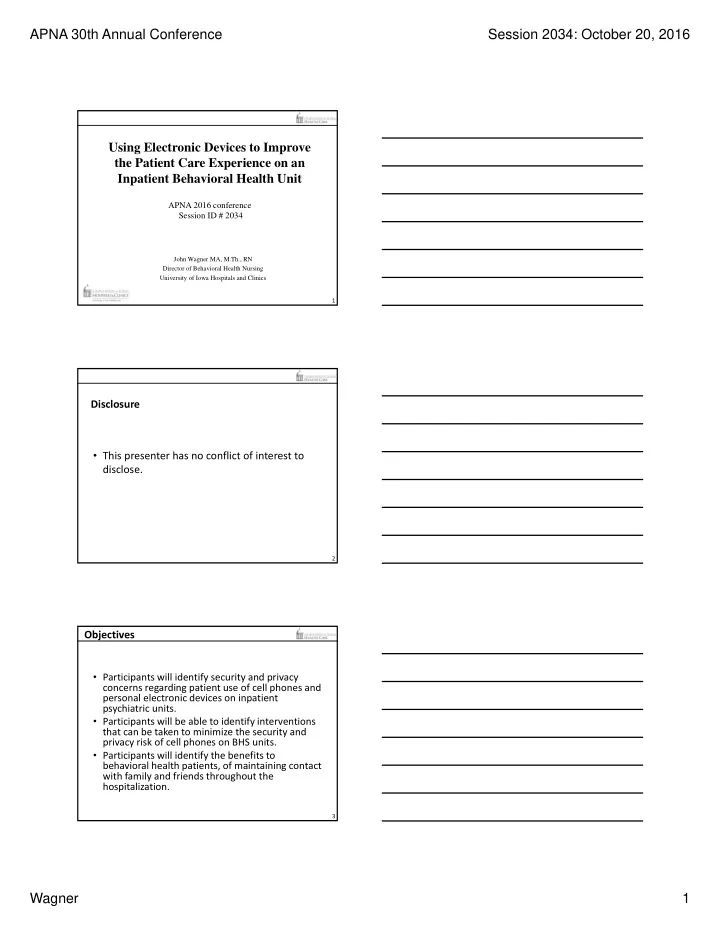

APNA 30th Annual Conference Session 2034: October 20, 2016 Using Electronic Devices to Improve the Patient Care Experience on an Inpatient Behavioral Health Unit APNA 2016 conference Session ID # 2034 John Wagner MA, M.Th., RN Director of Behavioral Health Nursing University of Iowa Hospitals and Clinics 1 Disclosure • This presenter has no conflict of interest to disclose. 2 Objectives • Participants will identify security and privacy concerns regarding patient use of cell phones and personal electronic devices on inpatient psychiatric units. • Participants will be able to identify interventions that can be taken to minimize the security and privacy risk of cell phones on BHS units. • Participants will identify the benefits to behavioral health patients, of maintaining contact with family and friends throughout the hospitalization. 3 Wagner 1
APNA 30th Annual Conference Session 2034: October 20, 2016 History of Cell Phones Development • 1992 The first digital cellphone • 1996 The first flip phone • 2002 The first camera phone • 2003 The first Blackberry • 2004 The first Smartphone • 2007 The first I-Phone 4 Adults in the USA who own a: Cellphone Smartphone • 2002 64% 0% • 2004 68% 0% • 2008 78% 0% • 2010 82% 35% • 2012 84% 45% • 2014 90% 58% • 2015 68 % 92% 5 Cellphones have become imbedded into the lives of many adults. • Much like individuals who smoke or drink may experience varying withdrawal reactions when hospitalized • Loss of access to cell phones can cause anxiety ranging from minimal to severe 6 Wagner 2
APNA 30th Annual Conference Session 2034: October 20, 2016 Cellphone use by hospitalized patients • Once use was prohibited o Safety Concerns • Now use is common o Even expected • Tool to increase patient satisfaction o Avoidance of negative encounters o Maintain contact with friends and family 7 Smart phone use in hospitals? Study done at a large hospital in California • 79% for Entertainment or Games • 48% Access their Personal Health Record (PHR) • 44% Read about Condition/Treatment • 29% Read about Providers • 27%Read about Hospital Polices 8 Use of cellphones by those with persistent mental illness 2014 Study involving over 1,500 individuals • 98.8% owned a mobile device • 91.6% used it to talk • 38.8% used it to text • 33.2% used it to access the internet 9 Wagner 3
APNA 30th Annual Conference Session 2034: October 20, 2016 Things Change? • Most patients on BHS units own cellphones – Of these, more and more are smart phones • BHS patients like to use their cell/smart phones o Just like everyone else • Not allowing access to cell phone causes issues o Don’t know the phone numbers of family and friends o Text is often the preferred method to communicate o View this restriction more and more as unacceptable 10 10 Why cellphones aren’t allowed on Behavioral Health Units • Confidentiality o Cameras o Sound recording • Expense • Perceived danger 11 Why Cell Phones aren’t allowed on BHS units (cont.) • Unforeseen consequences • Unknown Contacts • Illicit contacts • Loss of control 12 Wagner 4
APNA 30th Annual Conference Session 2034: October 20, 2016 Why we considered change at UIHC • Patients were becoming increasingly affected • Staff spending more effort on this issue • An unnecessary restriction for most patients o Because of the concerns of a few • Inconsistent with other precautions o Suicide o Phone Restrictions o Sexually acting out behaviors 13 13 In the end, the difficulties were to great • Psychiatrists • Administration • Hospital Legal • Compliance • Security And then it all changed with one visit And a strong partnership with Psychiatry 14 14 Cellphone Camera • Industrial Espionage Tape o Changes color when removed o Check the phones daily to determine if phone has been removed o Zero tolerance for removal of strip o Collaboration with Hospital Legal and Security o Most Wired Hospital status is helpful 15 15 Wagner 5
APNA 30th Annual Conference Session 2034: October 20, 2016 Develop patient cellphone expectations • All staff/disciplines need to be in agreement o Use of cellphone is a privilege not a right o No use of cellphones in groups o Camera strip must remain inplace o No use of sound recording o Patient cannot choose to use phone instead of attending therapies o Assess every patient for risk Sexually Acting Out Behaviors Manic patients 16 16 Lessons learned from previous innovation • There is an expectation to determine what success looks like • To determine an intervention • Measure the effect of the intervention • Evaluate the data • Make decisions improvements based on that data o The Iowa Model 17 17 Methodology of the Study Established survey tool • Social and Emotional Loneliness Scale for Adults UIHC developed survey tool • No survey tool existed to meet our needs o Developed for inpatient psychiatric unit o Measured perception of remaining connected o Measure connectedness to society 18 18 Wagner 6
APNA 30th Annual Conference Session 2034: October 20, 2016 Methodology of the Study (cont.) • Pre and Post Survey Strategy o Magnet Project o One pre survey group o Three follow up survey groups • Survey population • Types of units involved o Types of patients 19 19 Results 20 20 Lessons Learned 21 21 Wagner 7
APNA 30th Annual Conference Session 2034: October 20, 2016 Questions? 22 22 Wagner 8
Recommend
More recommend